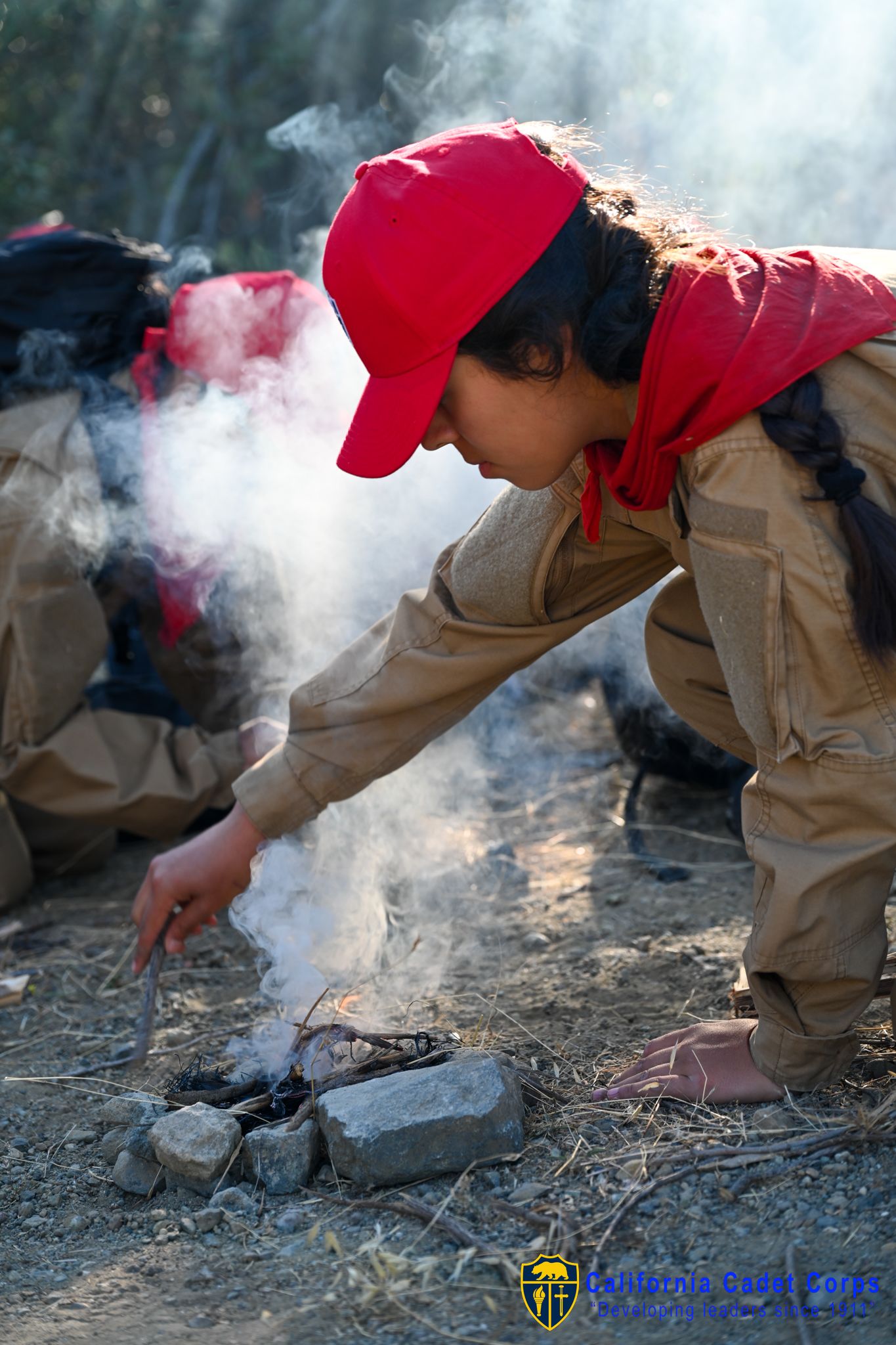Cadets rise to the challenge in California Cadet Corps’ intense survival course
California Cadet Corps survival program prepares students for life, leadership, and how to survive

by Capt. James Colbert
California Cadet Corps Public Affairs
July 15, 2024
SAN LUIS OBISPO, Calif. -- This summer, the California Cadet Corps conducted its rigorous, weeklong survival course, the Survival FTX, at Camp San Luis Obispo. The course, from July 13 to July 20, allowed cadets to expand their physical and mental limits in the wilderness. Those who completed the program earned the right to wear the distinguished red beret, symbolizing their endurance and newly acquired skills.
The course was divided into three levels: 65 cadets took the Basic Survival Course, 20 returned for the Advanced Survival Course, and three returned for a third time, aiming to become cadet survival instructors.
California State Guard 1st Sgt. Dustin Dionne, the noncommissioned officer in charge at Cadet Corps headquarters and overall leader of the Survival FTX, emphasized that safety is paramount. "We begin with a deliberate risk assessment and implement necessary controls,” he said.
Cadet 1st Lt. Ariyah Brazell, with Porterville Military Academy, uses flint and steel to safely start a fire during the Survival Field Training Exercise at Camp San Luis Obispo, Calif., July 15. The course emphasizes hands-on survival skills and resilience in the wilderness. (California Cadet Corps photo by Capt. Ericka Radcliff)
Cadet 1st Lt. Ariyah Brazell, with Porterville Military Academy, uses flint and steel to safely start a fire during the Survival Field Training Exercise at Camp San Luis Obispo, Calif., July 15. The course emphasizes hands-on survival skills and resilience in the wilderness. (California Cadet Corps photo by Capt. Ericka Radcliff)
“Even though it might seem like the cadets are struggling, there’s a deliberate thought process on keeping them healthy and setting them up to succeed," Dionne explained. The instructor team closely monitors the cadets, especially first-timers, to help them overcome mental and physical challenges. "Typically, 60% of the first-year cadets will want to go home at some point. We have a three-step process to help them through that decision because our goal is for everyone to earn the red beret."
The advanced survival course, led by seasoned educator and biology teacher Dan Leavell, pushes cadets further, requiring them to apply their skills independently. "These cadets spend significant time alone, carrying out the survival tasks they learned during the basic course. Unlike Basic Course cadets who sleep in tents, the Advanced course cadets sleep in shelters they constructed from foraged materials apart from the other cadets," Leavell said.
Leavell, who has been a classroom teacher for 16 years and the commandant of cadets at Altus Charter School in San Diego for eight years, highlighted the broader impact of the Cadet Corps on students. "Everything we do is about teaching cadets to push through barriers. The survival course accelerates their growth, building self-confidence and leadership skills that translate into better performance in school and beyond."
Cadets participate in a challenging endurance hike as part of the Survival Field Training on July 16. (California Cadet Corps photo by Capt. Ericka Radcliff)
Cadets participate in a challenging endurance hike as part of the Survival Field Training on July 16. (California Cadet Corps photo by Capt. Ericka Radcliff)
Cadet Maj. Jasper Higle, a senior at La Sierra Military Academy, represents the transformative power of the California Cadet Corps. Once a shy seventh grader grappling with personal challenges, Higle has risen through the ranks to become a respected cadet leader. He reflected on his journey: "The Cadet Corps has always been a home away from home for me. It helped me become someone others can rely on."
Higle’s six years in the Cadet Corps showcase the impact of the Applied Leadership Model. His achievements include serving as a battalion administrative officer, earning his Cadet Medic qualification, and completing all three levels of the rigorous survival training course.
This progression has not only honed his leadership skills but also translated into academic success.
“My grades have improved, as has my behavior in class,” Higle shared. “Now, I’m always ensuring that I participate in class, keep up with my homework, and stay focused.”
The Cadet Corps provided Higle a path to serve others, fostering his personal growth. “I love helping people. When I was young, there were situations where people close to me needed assistance, and I could not. The Cadet Corps helped me develop a sense of self that can help others,” he said. Higle recalled his first survival course, “I felt like I was that cadet everybody had to carry. From then on, I dedicated myself to becoming someone others could lean on.”
Earning the Cadet Survival Instructor title is a testament to his dedication and growth.
As the cadets wrapped up their week at Camp San Luis Obispo, they left with newfound confidence and resilience, ready to take on the challenges that await them, both in the classroom and life.
Cadets who graduated from this year’s Survival Field Training Exercise receive a motivational speech from 1st Sgt. Dustin Dionne on July 20. (California Cadet Corps photo by Capt. Ericka Radcliff)
Cadets who graduated from this year’s Survival Field Training Exercise receive a motivational speech from 1st Sgt. Dustin Dionne on July 20. (California Cadet Corps photo by Capt. Ericka Radcliff)





